By Charles Morgan for CoinWeek …..
1794 Flowing Hair Cent (Head of 1794) in AU58 to MS63
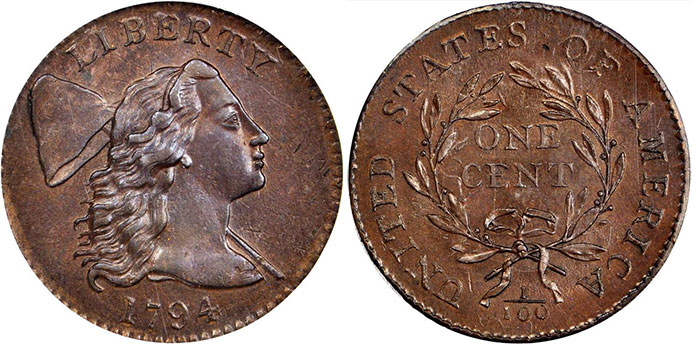
The Flowing Hair cent was produced starting at the end of 1793 and continuing through 1796. An American interpretation of–and, to my eye, an improvement upon–Augustin Dupré’s Libertas Americana medal, the Flowing Hair cent was the third and last cent design issued in 1793. Amazingly, all three are attributed to the same man: watch repairman and engine builder-turned coin engraver Henry Voight.
The 1793 Flowing Hair cent is actually the cent with the lowest mintage from 1793 and is quite rare. But for me, the 1794 Head of 1794 issue is the best realization of the design. It’s a design that I have loved ever since I first discovered it, flipping through the pages of my first Red Book in 1986.
Examples I have handled over the years have run the gamut, from the finest known to severely worn or impaired pieces saved from the melting pot as large cents were redeemed in the 1850s to make way for the new smaller cent. From an aesthetic point of view, any good, cared-for piece with discernable details above VF can come very nice. Conversely, I’ve also seen coins graded in AU and low Mint State that I find absolutely uninteresting.
The right coin for me would have to be struck on a nice planchet, retain nearly all of its original detail as struck, and be devoid of dark toning spots or any evidence of corrosion.
I want all of the coins on my list, but this would be the one I’d cherish forever.
1795 Capped Bust to Right Eagle in AU50 to AU58
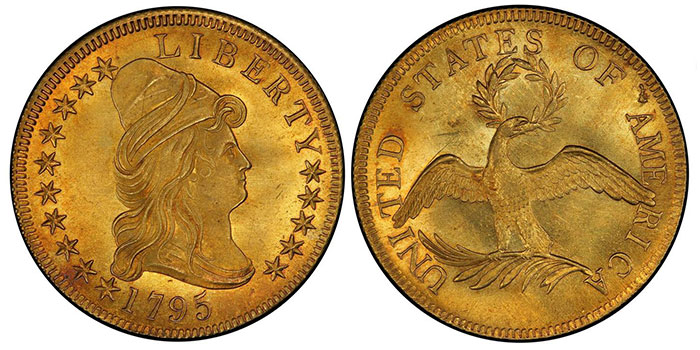
I’ve heard David Hall on numerous occasions describe the early U.S. “Big Ten” gold eagles as the “beachfront property” of American numismatics. He’s not wrong. These gorgeous gold coins were the largest denomination struck by the early Mint and the coupling of the Capped Liberty on the obverse and the small eagle on the reverse epitomized the height of American coin art in the 18th century. It would take until 1907 for this design to be rivaled on a $10 gold coin and given the size differential between the two coins it’s hardly fair to compare them to one another.
A coin like the one pictured above is the finest known of the 13 Leaves reverse. Its pedigree has been traced back to the last decades of the 19th century but is more recently known as the Garrett-Pogue specimen. A coin of tremendous importance and rarity, those with aspirations to own it must wait decades for a chance and have millions of dollars to spare. I was lucky enough to be on hand when the coin brought a jaw-dropping $2.585 million USD at the second Pogue sale. I couldn’t afford it then, and I probably won’t be able to afford it whenever it comes back on the market. Still, it’s a coin I’d love to own.
1848 CAL. Gold Quarter Eagle in AU-55
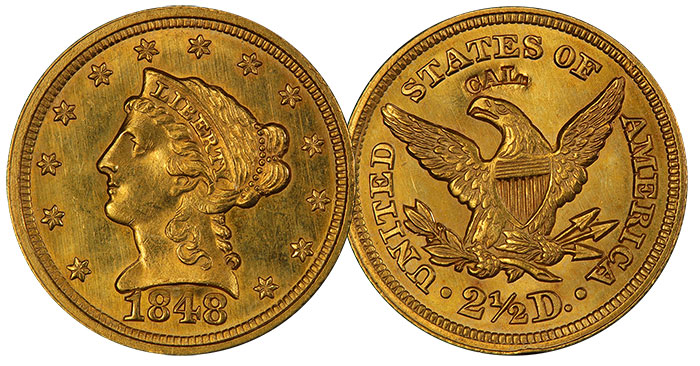
The 1848 “CAL.” quarter eagle is a unique federal issue that has a direct connection to the California Gold Rush.
In total, 1,389 coins were struck using $3,910.10 worth of refined gold delivered to War Secretary William L. Marcy from California Military Governor Richard Mason. The incuse CAL. was individually stamped onto the coin’s reverse above the eagle’s head, presumably while the coins were still in the die. The handmade nature of the pieces is evident given the drift of the CAL. counterstamp, which floats between the A in STATES to the various positions under the T.
Although dated 1848, these coins were struck in early 1849. An argument can be made that this represents the first commemorative issue of United States coinage. Documentary evidence supports this claim, but I am sympathetic to the argument that it is not of a kind with the commemorative coin designs of 1892-1954.
Even though 1,389 were struck, less than a few hundred survive. Not many were bought at the time, but fortunately for collectors, the unsold stock was released into circulation, which explains why the issue is most often encountered in circulated grades.
1850 Baldwin Ten Dollars, Horseman Type
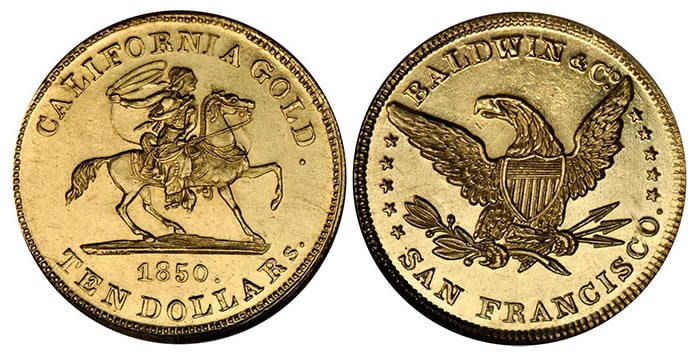
The first time I handled a Baldwin $10 gold coin of the Horseman Type was in 2017 when I met up with dealer Russ Augustin to produce a video on the coin. The video, which can be seen here, was fun to produce and served as a good primer for anyone who wanted to learn more about the company and the origin of the iconic obverse design.
Gold discoveries in the American West dramatically changed the country, fueling economic prosperity and sending waves of settlers out west to seek new fortunes. The authority to strike coins had been spelled out in the U.S. Constitution as solely lying with the federal government, but the speed of discovery and the challenges of geography and bureaucracy meant that Washington couldn’t keep up the pace. As a result, private coinages emerged, and gold coins bearing the names Bechtler, Wass. Molitor, Humbert, and others emerged.
This Baldwin piece is one of the most distinctive of all the private California issues. It is seldom seen and perhaps fewer than 15 survive. It likely didn’t circulate as widely as issues by other makers, but it is a fantastic representation of San Francisco in its bawdy heyday.
This particular example is one of the finest known and brought $281,750 when it sold more than a decade ago.
1907 Indian Head Eagle in MS63 or Better
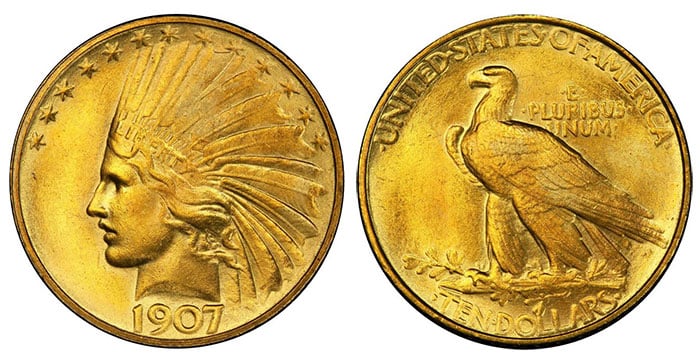
Maybe I’m an outlier, but I’ve never really been all that into Augustus Saint-Gaudens’ double eagle design as produced in lower relief. As originally intended, it marked a huge artistic improvement over Longacre’s Liberty, but to my taste, the better Saint-Gaudens design was used for the $10 gold coin. It’s a minor miracle that either got made.
In February of 1907, President Teddy Roosevelt reviewed the designs of the $10 gold coin and suggested that Saint-Gaudens modify his portrait of Liberty, replacing the laurel wreath that rested atop her hair with a Native American war bonnet. A similar motif had been used before on American gold coinage and was still employed on Longacre’s one cent design.
Saint-Gaudens reworked the design to Roosevelt’s specifications. In this particular instance, Roosevelt was proven correct – the design popped! Stricken with cancer, Saint-Gaudens along with his assistants hurriedly worked to complete the designs, sending plaster models for the $10 to the Philadelphia Mint in June. After a week of review, Chief Engraver Charles Barber informed the Mint’s superintendent that the models were not appropriate for striking coins. Saint-Gaudens’ assistant Henry Hering was tasked with revising the models, which he returned to the Mint on July 19, just two weeks before Saint-Gaudens died.
The coin pictured above is one of about 50 that survive from an original striking of 31,500 pieces. The coin was likely produced in the week of September 13, 1907. This particular example was from the collection of D. Brent Pogue and is one of the finest known. The last public sale of this coin brought $576,000.
1909-O Indian Head Half Eagle
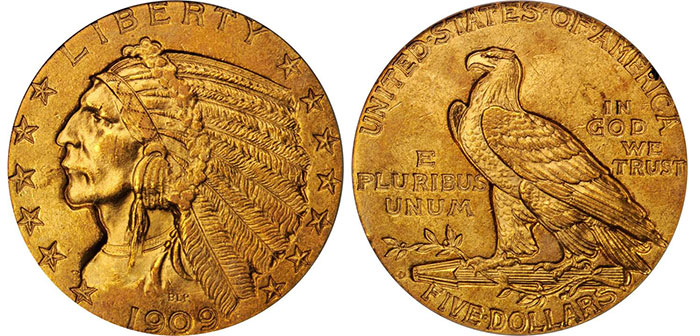
The 1909-O is an anomaly in the often-overlooked gold coin type for it is the only New Orleans gold issue struck in the 20th century. Bela Lyon Pratt’s incuse Indian Head design may have seemed to be an incongruent pairing to Augustus Saint-Gauden’s elegant eagle and double eagle designs, given that the latter was notorious for its ultra-high relief, but in time, collectors have warmed up to it.
For me, this design is all about the obverse: the visage, the headdress with its gentle downward slope, and the intricate feather detail. All of it combines to form one of the most distinctive and realistic portraits ever executed on a U.S. coin. The Indian Head/Buffalo nickel that debuts five years after this design’s debut leans more on this aesthetic than the one used by Saint-Gaudens on the Indian $10.
In Mint State, this is a prohibitively expensive coin. One of a trio of Indian half eagle key issues, the 1909-O is probably the rarest of the three in absolute terms. Truly nice examples survive, but they are highly-coveted six-figure coins that tend to find long-term homes in historic collections. A wish dream of a 20th-century coin if ever there was one.
1936 Gettysburg Half Dollar in High Grade with Nice Toning
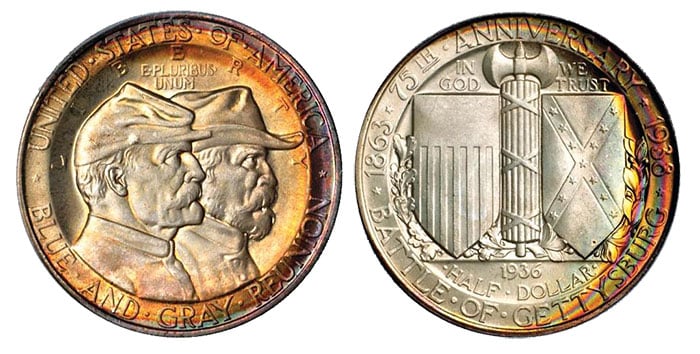
I’ve listed some way beyond my budget classics on this list so far, and it’s almost certain that I’ll never afford them. The 1936 Gettysburg half dollar does not fall in that same category, and even though it is one of my very favorite U.S. coin designs, I’ve never made the leap to purchase one. It’s not that it’s a prohibitively expensive coin, it’s just that my collecting pursuits have never put me in a position to prioritize purchasing one. In reflecting on that, I wonder why? Certainly, I could have done without something in the past ten years that would have cleared up the budget to finally buy one.
This half dollar was struck at the height of the classic commemorative coin boom. House Resolution 11533 was introduced in April 1936 and passed in May. The Pennsylvania State Commission selected artist Frank Vittor to design the coin’s obverse and reverse, and in my opinion, he did a great job. The Commission had hoped that they could increase interest in the issue by having all three mints strike the coin. They even produced three-coin holders that inform the buyer that 20,000 pieces were struck at Philadelphia, 15,000 at Denver, and 15,000 at San Francisco. This was not the case. 50,028 coins (28 for Assay) were struck at Philadelphia and 23,1000 of those went unsold and were melted, leaving a distribution of 26,900.
Today, a Gem Gettysburg half can be had for $600 to $750. A large accumulation of them turned up recently and was being sold through various dealers. The coin above is an attractive upper-end example with an interesting auction history. Offered by Stack’s Bowers in January 2006 as part of The Robert Michael Prescott Collection, the coin sold for $8,625.
In August of that year, the coin sold again for $27,600. The reason for the price increase? In January the coin was housed in a PCGS MS67 holder. In August it was offered as an NGC MS68*. Same beautiful coin.
1950 Franklin Half Dollar in Proof 67-68 DCAM
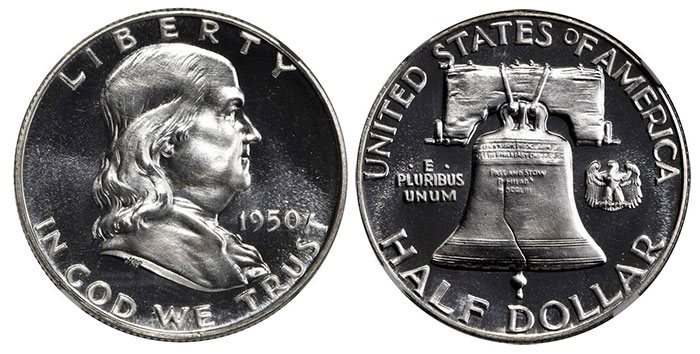
Franklin half dollars are interesting coins. Proofs with Deep Cameo contrast occurred so infrequently in the early years of the series that they are essentially separate and apart from run-of-the-mill Franklin Proofs. They also fetch extraordinary premiums whenever an ultra-PQ one makes an appearance. Business strikes come with their own rules of the game. Here strike, luster, toning, and high state of preservation transform common modern coins into exotic mid-century numismatic trophy coins. I prefer the short simplicity of the Proof series and find the early (1950-1953) Proofs to be the most fascinating.
With the 1950 Proof, you have the first Proof of the series and the first of what I consider the “Proof Set” of the Mint’s “Midcentury Modern Period”. In that year’s set, only the Lincoln cent remains from the early 20th century’s artistic revival period. The Lincoln design, ahead of its time, was the vanguard of a shift from allegory to literalism.
To my taste, the Franklin design was the capstone of the movement. Its obverse features a bulbously rounded Franklin surrounded at the top and bottom inscriptions LIBERTY and IN GOD WE TRUST, both rendered at the same height. The reverse boasts a large Liberty Bell. Again a literal object. Offset to the side is a cartoonish impression of a heraldic eagle. Necessary by law, the eagle’s allegorical purpose is rendered insignificant.
Given their rarity, attractive upper-end 1950 Franklin Proofs with Deep Cameo contrast are prohibitively expensive to most collectors. The example pictured above brought $15,600 in a March 2021 Stack’s Bowers auction and it did not qualify as DCAM. It’s so close, however, and I have seen PR69DCAM Eisenhower dollars from 1973 and 1974 with less cameo than is found in this specimen.
1955 Lincoln Cent Doubled Die Obverse in MS65 RD
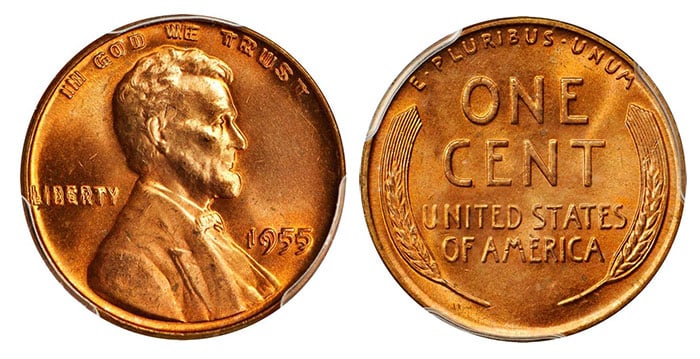
You can have your 1909-S V.D.B. or your 1943 copper cent. They’re majestic coins, but for me, the Lincoln cent I’m most in love with is the fantastically doubled 1955, especially Gem Mint ones with booming red color. As you might be able to tell by my write-up of the 1950 Franklin half dollar in Proof, I have a soft spot for the 1950s. And that interest extends beyond coins to other areas of history and culture. With the 1955 doubled die, you have an iconic design with unmissable doubling. Well, maybe not unmissable.
It’s said that many 1955 doubled dies were distributed along with packs of cigarettes in vending machines. That anecdote is fascinating as the operator of those machines must have coupled the coins with each pack of smokes by hand and never noticed the doubling. I wonder how many people put the coins in their pockets without taking a close look at the obverse. You can bet the ones who collect coins did.
The beautiful example pictured above is perhaps the finest known. It sold at a March 2018 Stack’s Bowers sale for $114,000.
1984 Los Angeles Olympics Three-Coin Proof Set
Not just any example would satisfy my desire, but the specific set once owned by my grandmother Ruth. My grandmother collected coins, mostly modern material and silver denominations pulled out of circulation in the 1960s and early ’70s. Her interest in coin collecting was passed down to at least one of her kids, the husband of her oldest daughter, and me.
I remember when these coins arrived in the mail, and I can’t see this year’s U.S. Olympic set without remembering that first spark that got me into the hobby. I have owned each and every one of these coins over the years, but this particular set is my “Rosebud”.
As a nine-year-old, I couldn’t have imagined that I would one day meet artist John Mercanti and call him a friend and his design features on the $10 gold coin. The Discus Throw silver dollar and the Olympic Stadium dollar are underrated designs in my opinion.
The set is currently held in a family collection, where it is appreciated. One day it might find its way back to me. I’d love to admire it again.





Very nice
1957 wheat penny, fair to good condition.
I have a 1955 double die penny for sale
Hello Dwight, what are you asking for it?